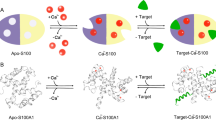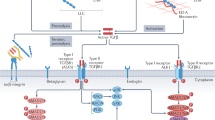Abstract
S100B, a calcium-binding protein of the EF-hand type exerts both intracellular and extracellular functions. S100B is induced in the myocardium of human subjects and an experimental rat model following myocardial infarction. Forced expression of S100B in neonatal rat myocyte cultures, and high level expression of S100B in transgenic mice hearts and aortic smooth muscle cells inhibit cardiac hypertrophy and the associated phenotype, arterial smooth muscle proliferation, respectively, but demonstrate increased apoptosis following α1-adrenergic stimulation or myocardial infarction. Knocking out S100B, augmented hypertrophy, decreased apoptosis and preserved cardiac function following myocardial infarction. S100B induces apoptosis by an extracellular mechanism by interacting with the receptor for advanced glycation end products and activating ERK1/2 and p53 signaling. The intracellular, and extracellular, roles of S100B are attractive therapeutic targets for the treatment of both cardiac and vascular disease.

Similar content being viewed by others
References
Anderson RE, Hansson LO, Vaage J (1999) Release of S100B during coronary artery bypass grafting is reduced by off-pump surgery. Ann Thorac Surg 67:1721–1725
Baudier J, Cole RD (1988) Interactions between the microtubule-associated tau proteins and S100b regulate tau phosphorylation by the Ca2+/calmodulin-dependent protein kinase II. J Biol Chem 263:5876–5883
Becker T, Gerke V, Kube E, Weber K (1992) S100P, a novel Ca(2+)-binding protein from human placenta. cDNA cloning, recombinant protein expression and Ca2+ binding properties. Eur J Biochem 207:541–547
Bierhaus A, Humpert PM, Morcos T, Wendt T, Chavakis T, Arnold B, Stern DM, Nawroth PP (2005) Understanding RAGE, the receptor for advanced glycation end products. J Mol Med 83:876–886
Chien KR, Zhiu H, Knowlton KU, Miller-Hence W, van Bilsen M, O’Brien TX, Evans S (1993) Transcriptional regulation during cardiac growth and development. Annu Rev Physiol 55:77–95
Delphin C, Ronjat M, Deloulme JC, Garin G, Debussche L, Higashimoto Y, Sakaguchi K, Baudier J (1999) Calcium-dependent interaction of S100B with the C-terminal domain of the tumor suppressor p53. J Biol Chem 274:10539–10544
Donato R (1999) Functional roles of S100 proteins, calcium-binding proteins of the EF-hand type. Biochim Biophys Acta 1450:191–231
Donato R (2001) S100: a multigenic family of calcium-modulated proteins of the EF-hand type with intracellular and extracellular functional roles. Int J Biochem Cell Biol 33:637–668
Donato R (2003) Intracellular and extracellular roles of S100 proteins. Microsc Res Tech 60:540–551
Donato R, Sorci G, Riuzzi F, Arcuri C, Bianchi R, Brozzi F, Tubaro C, Giambanco I (2009) S100B’s double life: intracellular regulator and extracellular signal. Intracellular and extracellular roles of S100 proteins. Biochim Biophys Acta 1793:1008–1022
Emoto Y, Kobayashi R, Akatsuka H, Hidaka H (1992) Purification and characterization of a new member of the S-100 protein family from human placenta. Biochem Biophys Res Commun 182:1246–1253
Frizzo JK, Tramontina F, Bortoli E, Gottfried C, Leal RB, Lengyel I, Donato R, Dunkley PR, Goncalves CA (2004) S100B-mediated inhibition of the phosphorylation of GFAP is prevented by TRTK-12. Neurochem Res 29:735–740
Goncalves DS, Lenz G, Karl J, Goncalves CA, Rodnight R (2000) Extracellular S100B protein modulates ERK in astrocyte cultures. Neuroreport 11:807–809
Griffin WS, Sheng JG, McKenzie JE, Royston MC, Gentleman SM, Brumback RA, Cork LC, Del Bigio MR, Roberts GW, Mrak RE (1998) Life-long overexpression of S100beta in Down’s syndrome: implications for Alzheimer pathogenesis. Neurobiol Aging 19:401–405
Heizmann CW, Cox JA (1998) New perspectives on S100 proteins: a multi-functional Ca(2+)-, Zn(2+)- and Cu(2+)-binding protein family. Biometals 11:383–397
Hu J, Van Eldik LJ (1996) S100 beta induces apoptotic cell death in cultured astrocytes via a nitric oxide-dependent pathway. Biochim Biophys Acta 1313:239–245
Hu J, Van Eldik LJ (1999) Glial-derived proteins activate cultured astrocytes and enhance beta amyloid-induced glial activation. Brain Res 842:46–54
Huttunen HJ, Kuja-Panula J, Sorci G, Agneletti AL, Donato R, Rauvala H (2000) Coregulation of neurite outgrowth and cell survival by amphoterin and S100 proteins through receptor for advanced glycation end products (RAGE) activation. J Biol Chem 275:40096–40105
Ikura M (1996) Calcium binding and conformational response in EF-hand proteins. Trends Biochem Sci 21:14–17
Katz AM (1990) Is heart failure an abnormality of myocardial cell growth? Cardiology 77:346–356
Kerkhoff C, Klempt M, Sorg C (1998) Novel insights into structure and function of MRP8 (S100A8) and MRP14 (S100A9). Biochim Biophys Acta 1448:200–211
Kilby PM, Van Eldik LJ, Roberts GC (1997) Identification of the binding site on S100B protein for the actin capping protein CapZ. Protein Sci 6:2494–2503
Kligman D, Marshak DR (1985) Purification and characterization of a neurite extension factor from bovine brain. Proc Natl Acad Sci USA 82:7136–7139
Kursula P, Lehto VP, Heape AM (2000) S100beta inhibits the phosphorylation of the L-MAG cytoplasmic domain by PKA. Brain Res Mol Brain Res 76:407–410
Leclerc E, Fritz G, Weibel M, Heizmann CW, Galichet A (2007) S100B and S100A6 differentially modulate cell survival by interacting with distinct RAGE immunoglobulin domains. J Biol Chem 282:31317–31331
Markowitz J, Rustandi RR, Varney KM, Wilder PT, Udan R, Wu SL, Horrocks WD, Weber DJ (2005) Calcium-binding properties of wild-type and EF-hand mutants of S100B in the presence and absence of a peptide derived from the C-terminal negative regulatory domain of p53. Biochemistry 44:7305–7314
Mazzini GS, Schaf DV, Vinade ER, Horowitz E, Bruch RS, Brunm LM, Goncalves CA, Bacal F, Souza DO, Portela LV, Bordignon S (2007) Increased S100B serum levels in dilated cardiomyopathy patients. J Card Fail 13:850–854
Mbele GO, Deloulme JC, Gentil BJ, Delphin C, Ferro M, Garin J, Takahashi M, Baudier J (2002) The zinc- and calcium-binding S100B interacts and co-localizes with IQGAP1 during dynamic rearrangement of cell membranes. J Biol Chem 277:49998–50007
Millward TA, Heizmann CW, Schafer BW, Hemmings BA (1998) Calcium regulation of Ndr protein kinase mediated by S100 calcium-binding proteins. EMBO J 17:5913–5922
Morgan HE, Baker KM (1991) Cardiac hypertrophy: mechanical, neural and endocrine dependence. Circulation 83:13–25
Most P, Boerries M, Eicher C, Schweda C, Ehlermann P, Pleger ST, Loeffler E, Koch WJ, Katus HA, Schoenenberger CA, Remppis A (2003) Extracellular S100A1 protein inhibits apoptosis in ventricular cardiomyocytes via activation of the extracellular signal-regulated protein kinase ½ (ERK1/2). J Biol Chem 278:48404–48412
Newton RA, Hogg N (1998) The human S100 protein MRP-14 is a novel activator of the beta 2 integrin Mac-1 on neutrophils. J Immunol 160:1427–1435
Parker TG (1993) Molecular biology of cardiac growth and hypertrophy. Herz 18:245–255
Parker TG, Schneider MD (1991) Growth factors, proto-oncogenes and plasticity of the cardiac phenotype. Annu Rev Physiol 53:179–200
Peskind ER, Griffin WS, Akama KT, Raskind MA, Van Eldik LJ (2001) Cerebrospinal fluid S100B is elevated in the earlier stages of Alzheimer’s disease. Neurochem Int 39:409–413
Portela LV, Brenol JC, Walz R, Bianchin M, Tort AB, Canabarro UP, Beheregaray S, Marasca JA, Xavier RM, Neto EC, Goncalves CA, Souza DO (2002) Serum S100B levels in patients with lupus erythematosus: preliminary observation. Clin Diagn Lab Immunol 9:164–166
Rempiss A, Greten T, Schafer BW, Hunziker P, Erne P, Katus HA, Heizmann CW (1996) Altered expression of the Ca(2+)-binding protein S100A1 in human cardiomyopathy. Biochim Biophys Acta 1313:253–257
Rustandi RR, Baldisseri DM, Weber DJ (2000) Structure of the negative regulatory domain of p53 bound to S100Bb. Nat Struct Biol 7:570–574
Santamaria-Kisiel L, Rintala-Dempsey AC, Shaw GS (2006) Calcium-dependent and -independent interactions of the S100 protein family. Biochem J 396:201–214
Schmidt AM, Yan SD, Yan SF, Stern DM (2001) The multiligand receptor RAGE as a progression factor amplifying immune and inflammatory responses. J Clin Invest 108:949–955
Tsoporis JN, Marks A, Kahn HJ, Butany JW, Liu PP, O’Hanlon D, Parker TG (1997) S100B inhibits α1-adrenergic induction of the hypertrophic phenotype in cardiac myocytes. J Biol Chem 272:31915–31921
Tsoporis JN, Marks A, Kahn HJ, Butany JW, Liu PP, O’Hanlon D, Parker TG (1998) Inhibition of norepinephrine-induced cardiac hypertrophy in S100beta transgenic mice. J Clin Invest 102:1609–1616
Tsoporis JN, Marks A, Van Eldik LJ, O’Hanlon D, Parker TG (2003a) Regulation of the S100B gene by α1-adrenergic stimulation in cardiac myocytes. Am J Physiol 284:H193–H203
Tsoporis JN, Marks A, Zimmer DB, McMahon C, Parker TG (2003b) The myocardial protein S100A1, plays a role in the maintenance of normal gene expression in the adult heart. Mol Cell Biochem 242:27–33
Tsoporis JN, Marks A, Haddad A, Dawood F, Liu PP, Parker TG (2005) S100B expression modulates left ventricular remodeling after myocardial infarction in mice. Circulation 111:598–606
Tsoporis JN, Overgaard CB, Izhar S, Parker TG (2009) S100B modulates the hemodynamic response to norepinephrine stimulation. Am J Hypertens 22:1048–1053
Tsoporis JN, Izhar S, Leong-Poi H, Desjardins J-F, Huttunen HJ, Parker TG (2010) S100B interaction with the receptor for advanced glycation end products (RAGE). A novel receptor-mediated mechanism for myocyte apoptosis postinfarction. Circ Res 106 (in press)
Van Eldik LJ, Griffin WS (1994) S100 beta expression in Alzheimer’s disease: relation to neuropathology in brain regions. Biochim Biophys Acta 1223:398–403
Van Eldik LJ, Zimmer DB (1987) Secretion of S-100 from rat C6 glioma cells. Brain Res 436:367–370
Zimmer DB, Dubuisson JG (1993) Identification of an S100 target protein: glycogen phosphorylase. Cell Calcium 14:323–332
Zimmer DB, Cornwall EH, Landar A, Song W (1995) The S100 protein family: history, function and expression. Brain Res Bull 37:417–429
Author information
Authors and Affiliations
Corresponding author
Rights and permissions
About this article
Cite this article
Tsoporis, J.N., Mohammadzadeh, F. & Parker, T.G. S100B: a multifunctional role in cardiovascular pathophysiology. Amino Acids 41, 843–847 (2011). https://doi.org/10.1007/s00726-010-0527-1
Received:
Accepted:
Published:
Issue Date:
DOI: https://doi.org/10.1007/s00726-010-0527-1




